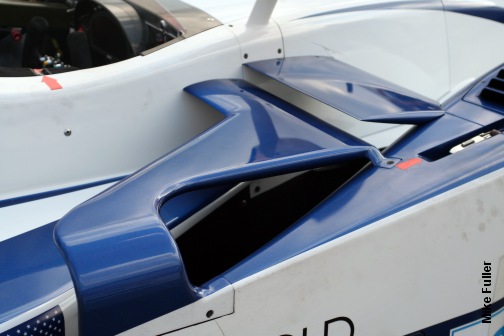 The
most controversial element on the '07 RS Spyder are the wing shaped valence
panels.
The
most controversial element on the '07 RS Spyder are the wing shaped valence
panels. 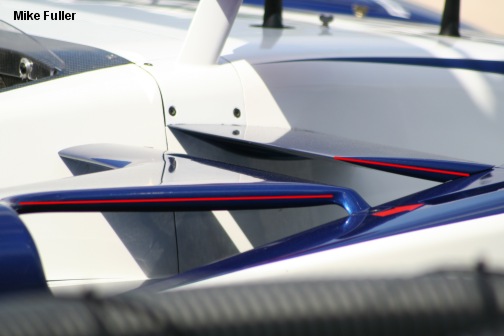 At
Sebring in 2007 I had a chance to speak with Michael Pfadenhauer and I
brought up the wing shaped valence panels. Pfadenhauer
was adamant that try as he would, in the end there was no aero performance
gain and indeed their application is pure rules compliance despite his
best efforts. He explained that in year's past there were always
unregulated "non-wing" wings in various areas of any given race car citing
examples such as the roll over hoop section as well as the typical car's
entire longitudinal cross section. From this conversation I got the
impression that Pfadenhauer's discussions with the ACO during the Spyder's
development prompted the ACO to go back and clarify the rules governing
"non-wing wings" hence many of the changes to Art. 3.6.1 in the 2007 ACO
regulations (see below).
At
Sebring in 2007 I had a chance to speak with Michael Pfadenhauer and I
brought up the wing shaped valence panels. Pfadenhauer
was adamant that try as he would, in the end there was no aero performance
gain and indeed their application is pure rules compliance despite his
best efforts. He explained that in year's past there were always
unregulated "non-wing" wings in various areas of any given race car citing
examples such as the roll over hoop section as well as the typical car's
entire longitudinal cross section. From this conversation I got the
impression that Pfadenhauer's discussions with the ACO during the Spyder's
development prompted the ACO to go back and clarify the rules governing
"non-wing wings" hence many of the changes to Art. 3.6.1 in the 2007 ACO
regulations (see below).
And it's in this feature in particular, if not concept here per Pfadenhauer's claim, that there is the potential to do some interesting things downstream of the valance panel that are of benefit to the car's aerodynamics (all one has to do is recall the development that went on in Indy Car racing in 2007 concerning side view mirrors, this was all geared towards creating beneficial aerodynamic interactions with the rear wing). But clearly there is no denying that there is an important relationship between the two valance panels on the RS Spyder, as noted by the lines running through the apparent centerlines depicting the approximate wing angle-of-attack. These angles are very deliberately set. If these panels aren't doing something to the airflow downstream, well then I'm Peter Pan.
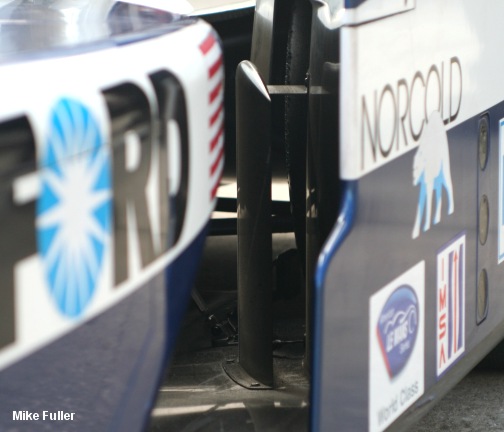 A
symmetrical wing is mounted vertically just aft of the front wheel.
Its purpose is to help condition the airflow exiting the front diffuser,
improving performance at various ride height/rake conditions (braking,
accelerating, etc.). Vertical wings such as these were made legal
under the 2007 revisions to Art. 3.6.1:
A
symmetrical wing is mounted vertically just aft of the front wheel.
Its purpose is to help condition the airflow exiting the front diffuser,
improving performance at various ride height/rake conditions (braking,
accelerating, etc.). Vertical wings such as these were made legal
under the 2007 revisions to Art. 3.6.1:
3.6.1 - With the exception of the rear wing defined in article 3.6.3, no bodywork or underbody element having a wing profile (*) is permitted :
(*) "Wing profile" : section generated by two arcs with different curves and/or centres joining a leading edge at the front to a trailing edge at the rear, the purpose being to exert an aerodynamic effect, lift or down force.
Are not considered as a wing profiles, the bodywork elements that:
•have a constant
thickness,
• have an absolutely
symmetrical profile,
• are vertical.
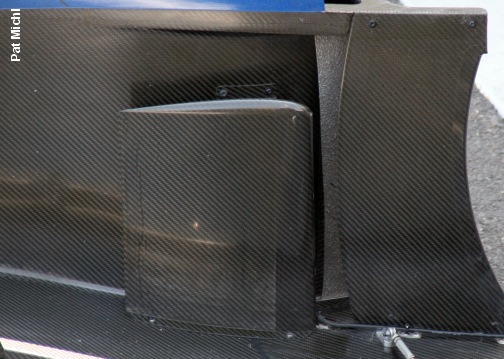 One
wonders if the proximity of the higher pressure airflow exiting out of
the front wheel well and acting on the outboard face of the vertical wing further enhances the wing's function?
One
wonders if the proximity of the higher pressure airflow exiting out of
the front wheel well and acting on the outboard face of the vertical wing further enhances the wing's function? At
the 2008 12 Hours of Sebring, Dyson Racing affixed
a gurney to the trailing edge of the front bodywork.
At
the 2008 12 Hours of Sebring, Dyson Racing affixed
a gurney to the trailing edge of the front bodywork.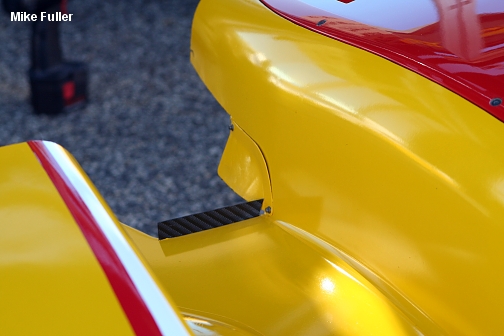 Penske
at Petit 2008. The add on piece is interesting and indicates that
Penske had that area opened up and got caught up in IMSA's recent clamp
down on Art 1.5.2 (photos from SLC '08 show it open). 1.5.2
says that the bodywork must cover all mechanical components of the car
as viewed from the top, side, front and rear. We're not
suggesting Penske was doing anything outside of the rules (look how
small the opening is; certainly the aero benefit is minimal), but
IMSA has been recently rigorously enforcing 1.5.2. Most had
reasonably interpreted "in side elevation" as meaning as seen from the
outboard elevation (looking in towards car centerline),. But the
ACO is insisting to also take into consideration as viewed (rather
difficultly) from an inboard longitudinal cross section looking
outboard.
Penske
at Petit 2008. The add on piece is interesting and indicates that
Penske had that area opened up and got caught up in IMSA's recent clamp
down on Art 1.5.2 (photos from SLC '08 show it open). 1.5.2
says that the bodywork must cover all mechanical components of the car
as viewed from the top, side, front and rear. We're not
suggesting Penske was doing anything outside of the rules (look how
small the opening is; certainly the aero benefit is minimal), but
IMSA has been recently rigorously enforcing 1.5.2. Most had
reasonably interpreted "in side elevation" as meaning as seen from the
outboard elevation (looking in towards car centerline),. But the
ACO is insisting to also take into consideration as viewed (rather
difficultly) from an inboard longitudinal cross section looking
outboard.  The Penske Porsche RS Spyder has a "shortened" nose. The
leading edge of the front fender is tucked in slightly and is noticeable
by the pronounced horizontal step between the nose surface and the
surface of the splitter. In standard form the nose is flush to the splitter return.
The Penske Porsche RS Spyder has a "shortened" nose. The
leading edge of the front fender is tucked in slightly and is noticeable
by the pronounced horizontal step between the nose surface and the
surface of the splitter. In standard form the nose is flush to the splitter return. Penske ran these low drag wheels in practice and qualifying for Petit '08. It was our understanding that these were
similar, if not identical, to the wheels Porsche presented to the ACO
at Le Mans and that were subsequently rejected. The big question
then became, so what made them legal this weekend? Sources
indicated the bone of contention may have simply been the method of
attachment for the flange, thus leading one to believe that the ACO
were presented with nut and bolt attached wheel flanges making the
wheels two-piece. But interestingly the regulations only recommend
one-piece wheels. Ultimately it appears that the flange is welded
on thus circumventing any ACO ire. Further digging revealed that
indeed these wheels were similar but that the flange as presented to
the ACO at Le Mans was made of carbon and cold bonded to the wheels.
So that would seem to confirm what we
heard about the Le Mans wheel presentation, that the main issue the ACO had with the wheels was
the method of attachment of the flange.
Penske ran these low drag wheels in practice and qualifying for Petit '08. It was our understanding that these were
similar, if not identical, to the wheels Porsche presented to the ACO
at Le Mans and that were subsequently rejected. The big question
then became, so what made them legal this weekend? Sources
indicated the bone of contention may have simply been the method of
attachment for the flange, thus leading one to believe that the ACO
were presented with nut and bolt attached wheel flanges making the
wheels two-piece. But interestingly the regulations only recommend
one-piece wheels. Ultimately it appears that the flange is welded
on thus circumventing any ACO ire. Further digging revealed that
indeed these wheels were similar but that the flange as presented to
the ACO at Le Mans was made of carbon and cold bonded to the wheels.
So that would seem to confirm what we
heard about the Le Mans wheel presentation, that the main issue the ACO had with the wheels was
the method of attachment of the flange.It is our understanding that Penske did not race the wheels due to concerns over brake cooling across a race stint further compounded across 1000 miles of racing.
